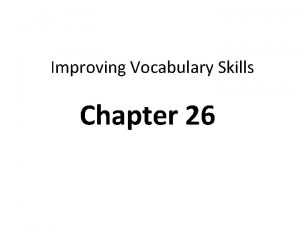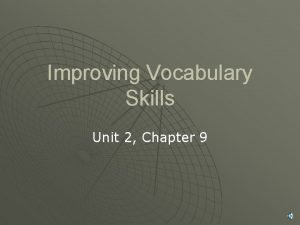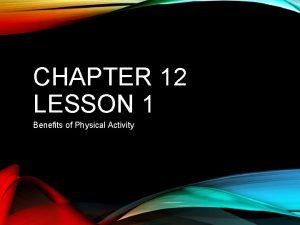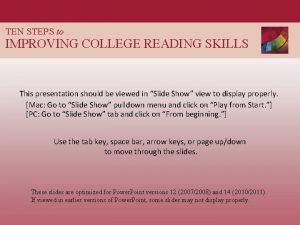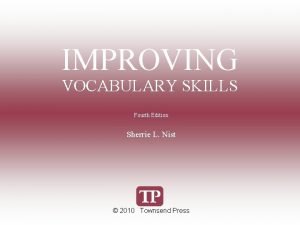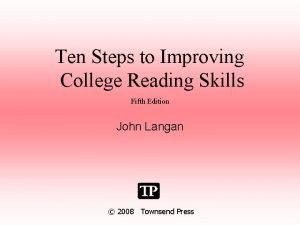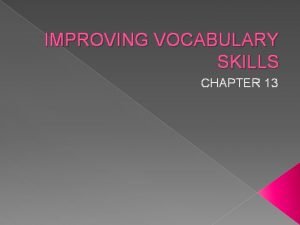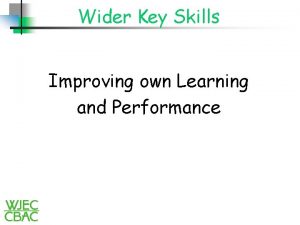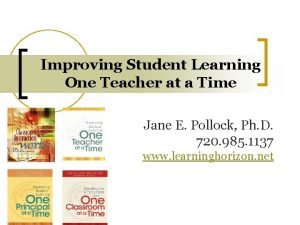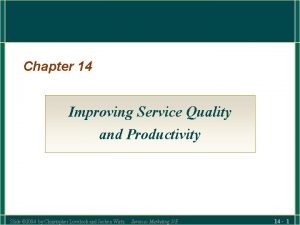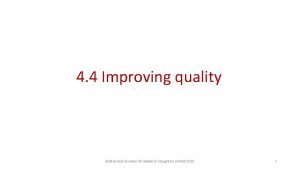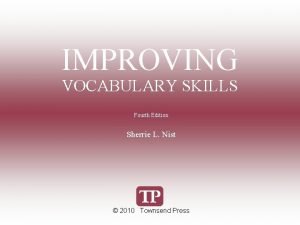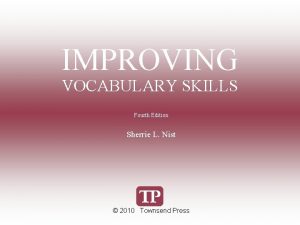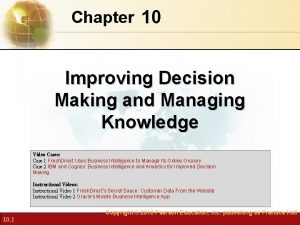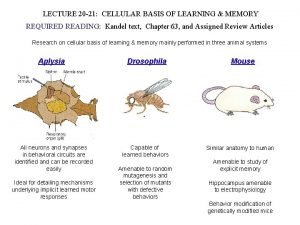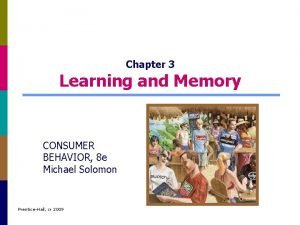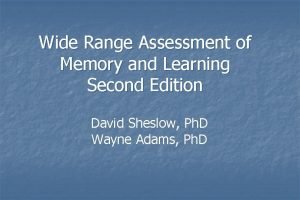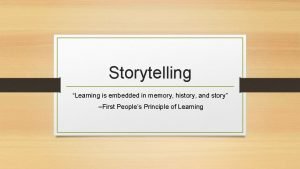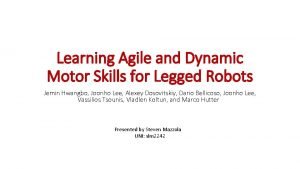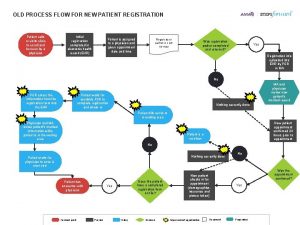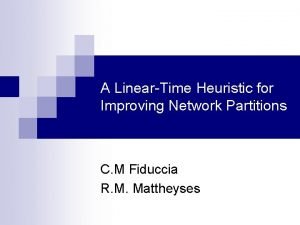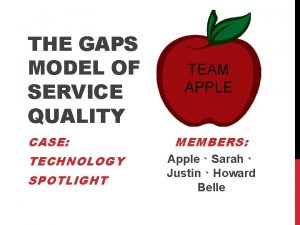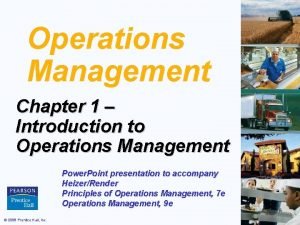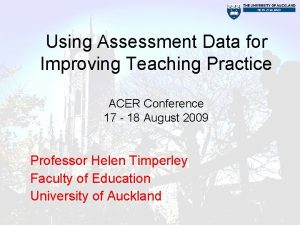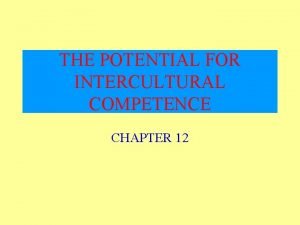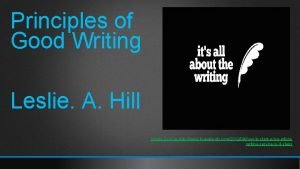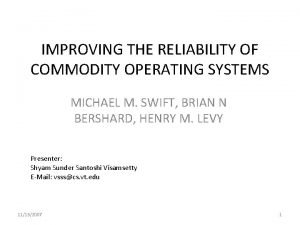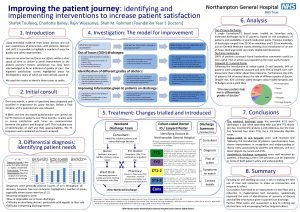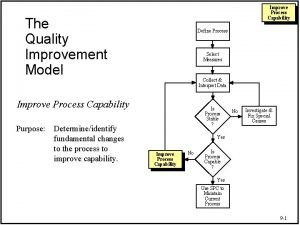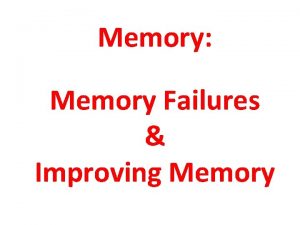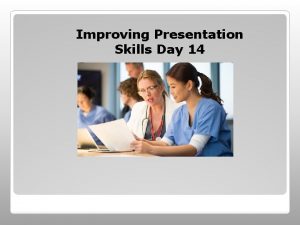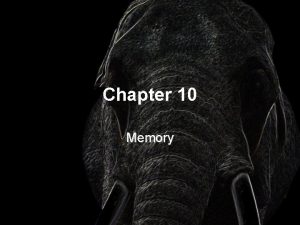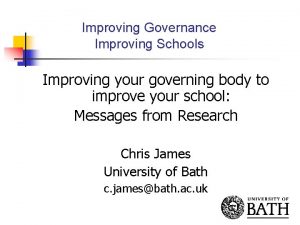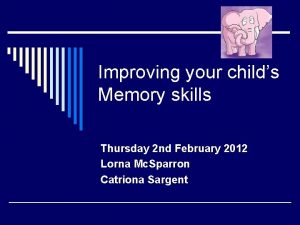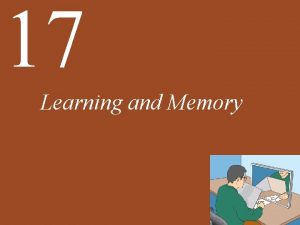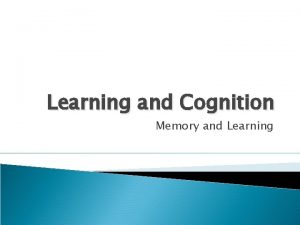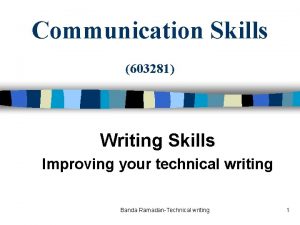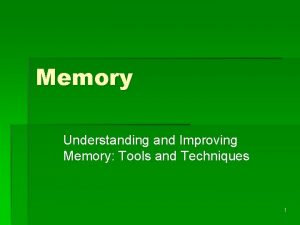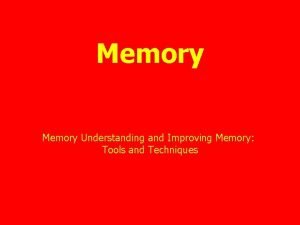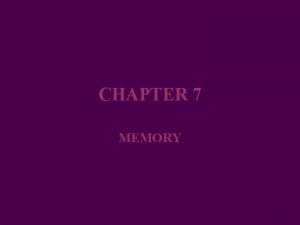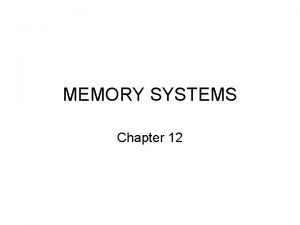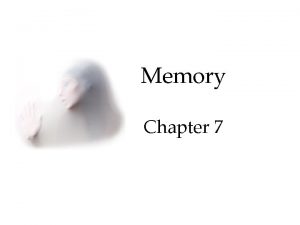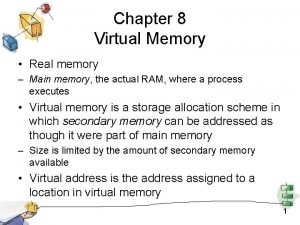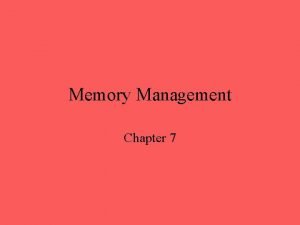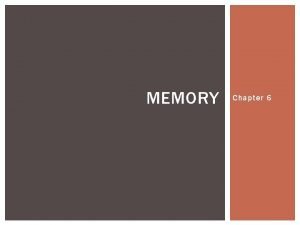Chapter 5 Improving Your Memory and Learning Skills




















































- Slides: 52

Chapter 5 Improving Your Memory and Learning Skills Copyright © 2016 by Tapestry Press, Ltd.

Purpose of This Chapter To help you gain some of the best learning strategies that will help you read to learn, remember what you learn, perform better on tests, and improve your learning confidence. Copyright © 2016 by Tapestry Press, Ltd.

College Creates Substantive Change in Individual Learners Every student at the college should undergo a substantial change in skill, knowledge, or attitude as a result of the student’s experience in every course. Copyright © 2016 by Tapestry Press, Ltd.

Learning Outcomes 1. Assess your learning strengths & weaknesses. 2. Improve your concentration. 3. Create a good study environment. 4. Understand & improve your memory. 5. Improve your reading comprehension. 6. Learn as you read. 7. Improve your reading comprehension & retention in mathematics & science reading assignments. 8. Challenge your self-talk study traps. Copyright © 2016 by Tapestry Press, Ltd.

Based on all you learned from this chapter, write what you think are your greatest: 1. Learning strengths 2. Learning weaknesses What will you do to overcome your learning weaknesses? Copyright © 2016 by Tapestry Press, Ltd.

Learning Weaknesses? There’s No Magic: 1. Overcoming a weakness is like getting in shape You have to work at it. 2. Be determined to figure out how to improve your weakness. 3. The greatest way to improve your weakness is just to jump in & try what you are bad at. 4. Practice it & you will get it! Copyright © 2016 by Tapestry Press, Ltd.

Use Positive Self-Talk to Jump Start Study Sessions 1. The biggest obstacle to effective studying is simply not starting. 2. Be your own coach with positive self-talk: � “Time to study now. I won’t regret it. ” � “I will start reading my chapter at 3, break at 4: 30, start again at 4: 45, & stop at 6: 30 unless I finish earlier. ” � “I will understand, learn, & get an ‘A’. ” 3. Self-talk doesn’t have to be sophisticated. 4. It’s so much healthier than, “I hate reading this stuff!” which gets you nowhere. 1. Positive self-talk also jump starts self-discipline. Copyright © 2016 by Tapestry Press, Ltd.

Self-Discipline is the Key to: 1. Creating & using productive study time. 2. Hurdling stress, distractions, & a host of other obstacles. 3. Achieving your dreams. 4. Remember that the sacrifice & self-discipline necessary for successful studying are also necessary for success in the workplace. Even self-discipline gets easier the more you use it! Copyright © 2016 by Tapestry Press, Ltd.

How to Overcome a Lack of Self-Discipline to Study? 1. Acknowledge your own responsibility. 2. Tell yourself that, “Procrastination will sink me!” 3. Allow yourself to feel the resistance—and then tell yourself, “I need to study. ” 4. Then study! 5. When you’re finished studying, tell yourself, “That wasn’t too difficult. ” 6. Relish in the fact that you did it—this will be a future source of motivation. Self-Talk always has a role in directing your actions! Copyright © 2016 by Tapestry Press, Ltd.

AGAIN Most Learning in College Takes Place Outside the Classroom Completing Assignments 1. 2. 3. 4. Reading Studying Activities/Projects Practice Remember allow a minimum of 2– 3 hours of study time per week for each hour of class time. OR until you master the material. Copyright © 2016 by Tapestry Press, Ltd.

Study Distractions compete with your need to concentrate and focus on studying. Quick: Once around the class List a study distraction (in the library or where you live) & how to eliminate or minimize it. Copyright © 2016 by Tapestry Press, Ltd.

Concentrate 1. Focus on one thing at a time. 2. Use Self-Talk to stay focused & concentrate. Ø “I will focus on my writing assignment for the next hour. ” 3. Minimize distractions: Know you have a choice to welcome or reject distractions. 4. Recognize when you need to rejuvenate. 5. You often need a break from some assignments so you can return with fresh ideas. 6. Get plenty of exercise & night-time sleep. Copyright © 2016 by Tapestry Press, Ltd.

A Good Study Environment Maximizes Learning 1. No distractions if possible. 2. A comfortable setting but one that keeps you awake & focused. 3. Establish a regular routine for study so you & others get accustomed to it. Where are your best campus study spots & why? Copyright © 2016 by Tapestry Press, Ltd.

Finding Your Best Time to Study 1. Do you do your best work at the crack of dawn? Or, are you a night owl? 2. Finding the right time to study is very important to learning. 3. Your preferences may change. Ø Too many 2 a. m. study nights is enough to make you rethink your best study time! Copyright © 2016 by Tapestry Press, Ltd.

Finding Your Best Time to Study continued 4. The key is to plan your day so: Ø You perform your hardest learning tasks at your best time. Ø Your easiest learning tasks at your least preferred or least productive time. Ø Make use of small amounts of time between classes, appointments, or activities. Have you identified your best times for learning/studying? Copyright © 2016 by Tapestry Press, Ltd.

Class Survey What are your most productive study times? 1. Early in the morning before ______ 2. In between classes 3. Right before dinner 4. Early evening 5. Late evening 6. Middle of the night 7. Other ______ 8. I take advantage of all of the above. Copyright © 2016 by Tapestry Press, Ltd.

Get ready to study 1. Stop everything & clear/relax your mind. Ø Avoid the negative thought creep. 2. Have a pleasant 5– 10 minute relaxation session visualizing clouds, the ocean, Christmas lights, the mountains, or listen to relaxing music. 3. Then stop & tell yourself, “I am ready to study. ” Copyright © 2016 by Tapestry Press, Ltd.

Break It Up! 1. Determine study start & stop times—maybe 50 minutes to 2 hours. What works for you? Knowing how long you plan to stay focused helps you stay on task! 2. Determine a target—“I’ll read 4 sections & then take a tea break. ” Copyright © 2016 by Tapestry Press, Ltd.

Study Breaks to Reenergize Your Mind 1. Take a walk 2. Have a glass of water to refresh. 3. What works for you? Copyright © 2016 by Tapestry Press, Ltd.

Time Plus Energy Equals Learning 1. There is no substitute for time on task. 2. Learning to use your time well is critical for you as a student as well as when you are a career professional. 3. Effective learning requires allocating realistic amounts of time. Copyright © 2016 by Tapestry Press, Ltd.

Memory 1. Memory is simply retrieval or recall of information that has been learned. 2. It is said that athletes & musicians have “muscle memory”—a repeatedly trained movement that becomes automatic. List other simple & complex skills or actions that have become automatic for you. Copyright © 2016 by Tapestry Press, Ltd.

“Learning” Has Several Meanings 1. The act, process, or experience of gaining knowledge or skill. 2. Knowledge or skill gained through schooling or study. 3. Psychology Behavioral modification especially through experience or conditioning. Copyright © 2016 by Tapestry Press, Ltd.

Difference Between Learning & Memory 1. What’s the difference? 2. Not all learning is transformed into lasting memories. 3. Learning is how you acquire new information; memory is how you store that information over time. 4. There is no memory without learning, but there is learning without memory. 5. For example, looking up a telephone number & remembering it just long enough to make your call is “working memory. ” It requires learning but not for the long haul. Copyright © 2016 by Tapestry Press, Ltd.

Learning vs. Memory Generally people don’t differentiate between learning & memory. What really counts is, are you working at it? Use your self-talk to direct your efforts! Copyright © 2016 by Tapestry Press, Ltd.

We’re Born to Learn Our brains were built to learn but our efforts toward learning must be based on the way the brain learns. 1. Brains grow neural circuits specifically for what is practiced. 2. If you practice math or anatomy & physiology, you are learning & growing new neural structures for this specific learning. 3. New learning takes more time & practice. 4. Without taking sufficient time to practice new information, you will not develop the foundation or the neural circuits for continued learning. 5. Whether you’re developing math or basketball skills, practicing basics will help you build a solid foundation for the next level of learning. Copyright © 2016 by Tapestry Press, Ltd.

How the Brain Remembers 1. The process of learning depends on a chain of electrical, chemical, & physical changes to the brain’s more than 100 billion nerve cells or neurons. 2. Repetition/practice increases the brain’s neural circuitry, & thus learning is remembered (stored in long-term memory). 3. Continued use (repetition) of information strengthens the memory. (Source: Rita Smilkstein, We’re Born to Learn, 2 nd Edition, Corwin, 2011. ) Copyright © 2016 by Tapestry Press, Ltd.

To learn & remember information you must: 1. Have the motivation or hunger to gain knowledge. Ø Note: Strong motivation may actually count more than your “IQ. ” 2. Discipline yourself to pay attention/concentrate, or you will miss it. 3. Work to understand before you can learn it. 4. Learn it before you can memorize it so it will be committed to long-term memory. See example next slide Copyright © 2016 by Tapestry Press, Ltd.

Example—Snow Skiing 1. Have the motivation to put energy & concentration into skiing. 2. Pay attention to & concentrate on the instructions. 3. Understand the concept of turning, e. g. , to turn right you put your weight on your left ski & slide your left ski to the downhill side. 4. Practice turning until it works fluidly & becomes automatic. All this effort removes the fear out of skiing. 5. With every skill you plan to learn you practice—practice reading, writing, math, terms, etc. Give an example of a skill or knowledge that, due to practice, is now part of your long-term memory. Copyright © 2016 by Tapestry Press, Ltd.

4 Memory Strategies 1. When you follow the way the brain naturally operates, you strengthen your learning & memory. 2. The learning & memory techniques described in the text will help you grow more neural circuitry—the brain’s natural way of learning. 3. Without memory strategies, you can begin to forget a reading assignment or lecture right away—up to 50% after 24 hours & 90% within a week’s time. 4. Good News: Information gets stored in long-term memory when you spend time studying it, repeating it, organizing it, thinking & writing about it, & using it. Copyright © 2016 by Tapestry Press, Ltd.

Group Teach: Strategies to Improve Your Memory 1. Divide into 6 groups. 2. Each group is assigned one of the 6 memory techniques discussed in the text. 3. Each group will deliver a motivational demonstration on its assigned memory technique & engage the class in the technique. 6 memory techniques next slide Copyright © 2016 by Tapestry Press, Ltd.

Six Memory Techniques 1. Understanding 2. Association 3. Recitation & Recall 4. Organizing Information 5. Visualization 6. Test Yourself Copyright © 2016 by Tapestry Press, Ltd.

Other Memory Techniques? Ø What other memory techniques have you learned that are worth recommending to your classmates? Copyright © 2016 by Tapestry Press, Ltd.

Downside to Learning 1. We learn what we practice, whether negative or positive. Ø Negative self-talk: “I hate studying. ” Ø Positive self-talk: “I love learning. ” 2. Avoidance of study is learned too! 3. Low expectations can also be learned! Good News you can override the negative & redirect your attitudes in a positive direction. Copyright © 2016 by Tapestry Press, Ltd.

Ever wonder who helps design your program curriculum? 1. Business & industries work with colleges to develop curriculum by recommending employee needs in: Ø General education Ø Major courses Ø Skill courses 2. There’s a lot of learning & remembering to prepare you for your future career. 3. Memory & learning techniques will help you learn what you need & grow more neural circuitry—the brain’s natural way of learning & remembering. Copyright © 2016 by Tapestry Press, Ltd.

At the base of your college success is: . . . feeling, believing, thinking, & hoping you will learn & succeed. 1. Remind yourself how important it is to stay focused on your academic & career goals. 2. Rid yourself of: “I’m bored!” or “I hate studying!” These thoughts do not nourish your drive or self-esteem. Copyright © 2016 by Tapestry Press, Ltd.

Use a Reading Method That Helps You Learn What You Read 1. Reading is perhaps the most used learning skill in college & in most professions. 2. Reading without both concentration & comprehension is almost like not reading. 3. The best reading methods help you concentrate, learn, & remember what you read. 4. They also set up practice tests in your text. Copyright © 2016 by Tapestry Press, Ltd.

PRQRT Step 1—Preview Step 2—Read, Question, and Recite Step 3—Test 1. Explain the details & purpose of PRQRT 2. How does PRQRT help you prepare for exams? Copyright © 2016 by Tapestry Press, Ltd.

SQ 3 R S = Survey Q = Question R = Read R = Recite R = Review 1. Explain the details of SQ 3 R Copyright © 2016 by Tapestry Press, Ltd.

When to Use SQ 3 R or PRQRT 1. Both study-reading methods are excellent techniques to use with textbooks that have a lot of information & require you to learn the material in depth such as biology, psychology, & sociology. 2. Both methods are probably less useful with math textbooks that focus on problem solving or foreign language courses which focus on vocabulary & grammar. 3. As you read & use the many learning, reading, & memory techniques outlined in this chapter, you will learn which help you most. Copyright © 2016 by Tapestry Press, Ltd.

Put Muscle into Your Math Reading 1. Slow down! You will need to stop to: � Practice problems so you can apply what you read. � Learn new math vocabulary & symbols so you won’t get lost. 2. Read from beginning to end of each chapter since each page assumes you have mastered previous pages. 3. Say: “It is important to understand each sentence before I go on. ” 4. Reread until you master a math concept or procedure. 5. Cover your text & recite, & practice anything you want to become a permanent part of your memory. Copyright © 2016 by Tapestry Press, Ltd.

Put Muscle into Your Math Reading continued 6. Make drawings of problems so you can visualize & understand. 7. Take time to understand diagrams & other illustrations. 8. When reading math, keep a pad of paper & a pencil in hand to stop & practice. Tell yourself: • “Learning math takes extra time for everyone but not learning math takes more time in the long run. ” • “Not learning math limits my career choices. ” • “I will discipline myself to practice math!” Copyright © 2016 by Tapestry Press, Ltd.

When reading & practicing math problems, ask yourself these questions: 1. What am I being asked to find? 2. What information am I being given? 3. What procedure(s) should I use? Copyright © 2016 by Tapestry Press, Ltd.

When solving math problems: 1. Always follow step by step to prevent mistakes & find your mistakes. 2. If possible, estimate answers before you compute. 3. Work neatly. Especially when working with decimals, it’s important to keep numbers lined up & in the right place. 4. Decide if the answer makes sense. 5. Proofread to check for mistakes. Copyright © 2016 by Tapestry Press, Ltd.

When solving math problems: continued 6. Check your answer by working backward. With equations, always plug in your answer for the unknown variable to see if it works. 7. Practice another example—create your own problem. 8. Understand & memorize mathematics facts & formulas to help you complete your work faster & more conveniently. Copyright © 2016 by Tapestry Press, Ltd.

Ways to Reduce Math Anxiety 1. Coach yourself with positive self-talk. 2. Don't hesitate get help from your instructor, other students, or tutors the same day you don’t understand something. 3. Consider math a foreign language—it must be practiced. 4. Don’t rely on memorization to study mathematics practice problems. 5. READ your math text & practice problems. 6. Study math according to your learning style. Copyright © 2016 by Tapestry Press, Ltd.

Ways to Reduce Math Anxiety continued 7. Be relaxed & comfortable while studying math. � Use relaxation techniques, such as stretching & deep, slow breathing when you feel anxious during study sessions or tests. 8. “TALK” mathematics. 9. At exam time, write down formulas or other memorized information as the test session begins. Then relax, knowing that you have important information available. 10. Develop responsibility for your own successes & failures. 11. If math anxiety still bothers you, talk to your instructor or your college’s counseling center. Copyright © 2016 by Tapestry Press, Ltd.

Reading Science & Technical Books 1. Be curious & develop questions about what you read — it will encourage you to read for answers. 2. You will need to slow your reading. 3. Look up terms you don’t know & then rehearse—you can write them on flash cards for practice. 4. Knowing & understanding terminology is essential to learning these subjects. Copyright © 2016 by Tapestry Press, Ltd.

Reading Science & Technical Books continued 5. Understand & learn procedures explained in texts by writing them in a step-by-step outline. Practice them either in your mind or in real life to put them in your long -term memory. 6. Draw or diagram to understand systems & processes explained in texts. 7. Organize information into charts to show the relationships between ideas. 8. Take time to understand text graphs & illustrations. Copyright © 2016 by Tapestry Press, Ltd.

Self-Talk Study Traps What self-talk study traps do you need to address & redirect to achieve your learning goals? Your self-talk will be the most important motivational factor in learning or not learning. Copyright © 2016 by Tapestry Press, Ltd.

Key Chapter Points 1. The techniques & strategies for improving your concentration, learning, memory, & reading in conjunction with the use of positive self-talk will give you greater control over your learning. . and learning promotes self-confidence. Copyright © 2016 by Tapestry Press, Ltd.

Key Chapter Points continued 2. Using SQ 3 R & PRQRT strategies helps you identify important information & anticipate possible test questions. Ø These reading methods are slower, but they will make studying faster because you have created self-tests that will prepare you for quizzes & exams. Copyright © 2016 by Tapestry Press, Ltd.

Key Chapter Points continued 3. Self-talk is perhaps the most important factor in learning. Ø Self-talk guides your determination as well as the direction you take with your study. Ø Your self-talk can help you avoid study or motivate you to study. Ø It can direct how you will study & how much you will study. Copyright © 2016 by Tapestry Press, Ltd.
 Condone noun form
Condone noun form Improving vocabulary skills chapter 9
Improving vocabulary skills chapter 9 Glencoe health chapter 12
Glencoe health chapter 12 A physical education chapter 12
A physical education chapter 12 Ten steps to improving college reading skills 6th edition
Ten steps to improving college reading skills 6th edition Chapter 2 sentence check 2 answers curt
Chapter 2 sentence check 2 answers curt Ten steps to improving college reading skills
Ten steps to improving college reading skills Chapter 13 sentence check 2 answers curtail
Chapter 13 sentence check 2 answers curtail Improving own learning and performance examples
Improving own learning and performance examples Improving student learning one teacher at a time
Improving student learning one teacher at a time Improving student learning one teacher at a time
Improving student learning one teacher at a time Internal memory and external memory
Internal memory and external memory Primary memory and secondary memory
Primary memory and secondary memory Virtual memory
Virtual memory Cuadro comparativo e-learning b-learning m-learning
Cuadro comparativo e-learning b-learning m-learning Semantic knowledge
Semantic knowledge Difference between implicit and explicit memory
Difference between implicit and explicit memory Long term memory vs short term memory
Long term memory vs short term memory Logical memory is broken into
Logical memory is broken into Which memory is the actual working memory?
Which memory is the actual working memory? Virtual memory in memory hierarchy consists of
Virtual memory in memory hierarchy consists of Eidetic memory vs iconic memory
Eidetic memory vs iconic memory Shared memory vs distributed memory
Shared memory vs distributed memory Intrapersonal skills
Intrapersonal skills Soft skills vs hard skills
Soft skills vs hard skills Give us your hungry your tired your poor
Give us your hungry your tired your poor Improving service quality and productivity
Improving service quality and productivity Difficulties of improving quality business
Difficulties of improving quality business Aliens meaning
Aliens meaning Improving vocabulary with word parts and context clues
Improving vocabulary with word parts and context clues Improving decision making and managing knowledge
Improving decision making and managing knowledge Cellular basis of learning and memory
Cellular basis of learning and memory Learning and memory consumer behavior
Learning and memory consumer behavior Wraml age range
Wraml age range Learning is embedded in memory history and story
Learning is embedded in memory history and story Ontario skills passport
Ontario skills passport Learning agile and dynamic motor skills for legged robots
Learning agile and dynamic motor skills for legged robots Olass - offender learning and skills service
Olass - offender learning and skills service Patient registration workflow
Patient registration workflow Nurses improving care for healthsystem elders
Nurses improving care for healthsystem elders Improving software economics in project management
Improving software economics in project management Improving software economics set 1
Improving software economics set 1 A linear-time heuristic for improving network partitions
A linear-time heuristic for improving network partitions Provider gap 4
Provider gap 4 Improving productivity at starbucks
Improving productivity at starbucks A sense of belonging improving student retention
A sense of belonging improving student retention Using assessment data for improving teaching practice
Using assessment data for improving teaching practice Behavioral assessment scale for intercultural competence
Behavioral assessment scale for intercultural competence Refactoring improving the design of existing code
Refactoring improving the design of existing code What is hill's prescription for improving one's vocabulary
What is hill's prescription for improving one's vocabulary Improving the reliability of commodity operating systems
Improving the reliability of commodity operating systems Improving the patient journey
Improving the patient journey Improving process capability means;
Improving process capability means;
